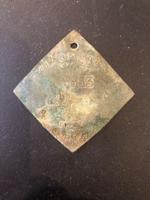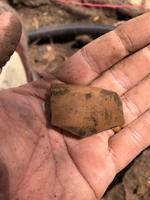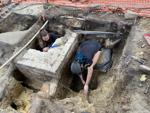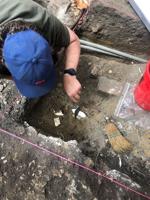SOUTH CAROLINA: Metal Badge Found At College of Charleston Illuminates History Of Urban Slavery
Metal badge found at College of Charleston illuminates history of urban slavery

The students knew they were working on the site of a 19th-century kitchen. Their archaeological dig turned up parts of the foundation of the structure, along with a hearth where the food was cooked.
They carefully removed the dirt — lots of dirt — filling 5-gallon buckets, then emptying them onto a quarter-inch screen used to filter the material.
The screen lets most of the loose dirt through, along with the smallest pieces of objects no longer recognizable or salvageable.
Left behind are the bigger bits. Many of them turned up during the work at 63½ Coming St., just south of Addlestone Library. There were pottery shards, animal bones and something else, something that will invigorate any urban archaeologist.
Lying atop the screen after the dirt fell through was a diamond-shaped piece of brass alloy.
These College of Charleston students under the guidance of professors Jim Newhard, Scott Harris and Grant Gilmore, had found a slave badge.

“It hung on someone’s neck,” said Newhard, director of the college’s Center for Historical Landscapes. “The enslaver — the owner — would put down a fee to the city and a tag would be issued, and the enslaved would then be able to be hired out to other places. The owner would get a cut, if not the entirety. Possibly, the enslaved would get something for his troubles.”
For those excavating urban sites and discovering such items today, a find like this stirs mixed feelings of excitement and distress.
“You just feel the evil,” Newhard said.
The only wording that’s still legible on the badge is “Charleston” and the year “1853.” The rest was discovered thanks to Gilmore’s dentist James Warner, who X-rayed the object to reveal the word “SERVANT” and badge No. 731.
Digging in the dirt
Thirty-six students in the Archaeology Program were involved in the dig, which was conducted in February and March on a site where a solar-powered pavilion is to be installed. During the planning process, the project coordinators determined the pavilion was to be constructed atop a buried structure identified on old Sanborn fire insurance maps as a kitchen.
“That prompted archaeology,” Newhard said.
The project had received federal funding from the U.S. Department of Energy, conveyed to the college by the S.C. Energy Office. That meant it was subject to the National Historic Preservation Act, whose provisions require protections of cultural assets.
The archaeology team needed to figure out what was underground, and how to ensure the pavilion project didn’t inflict damage.

They performed soundings of the ground and found a buried structure. During the excavations, they found bricks and a foundation, and they found what turned out to be an exceedingly helpful soda bottle.
The bottle, they discovered through research, was produced in Charleston only for two years, 1855 and 1856. This helped the team pinpoint the dates the kitchen likely was used.
They also found trash pits — an archaeologist’s dream find. Rummage through those and you can determine all sorts of things about the people who dumped their garbage there: what they ate, how they cooked it, what utensils they used, how much they consumed, and more.
The trash pits answered some questions and raised others. Were their contents the result of one big party, or an accumulation of regular meals over time? Who did the cooking? Who did the eating?
One thing was clear: A lot of oysters got shucked.
“Working on the site literally made me hungry a lot of days,” said Harris, director of archaeology. “We found ham bones, chicken legs, beef bones. … The students loved finding the bones.”

Badge No. 731
Slave badges functioned as tickets or passes, enabling the wearer to be hired out by his master in a specific category of labor, such as mechanic, huckster (fruit vendor), fisher, porter or servant.
They were likely introduced in the middle 1700s, and mandated by 1764, according to the book “Slave Badges and the Slave-Hire System in Charleston, South Carolina, 1783–1865,” by Harlan Greene and Harry Hutchins Jr.
Some of the first laws passed by the newly incorporated city of Charleston in 1783 pertained to the issuance of slave badges. In the early 1800s, the laws were standardized. Badges were valid for a year and sold to enslavers at various fees depending on the category of work.
The wearer could move with a degree of freedom throughout the city in order to fulfill his obligations, Gilmore wrote in an email.
Badge No. 731 was found adjacent to the hearth in the kitchen building that was excavated earlier this year, he noted.

“It may indicate that once the home was completed in the early 1850s that meals were prepared by a hired enslaved person,” Gilmore wrote.
It will be difficult, perhaps impossible, to determine to whom the badge belonged.
“The original City of Charleston ledger books recording the names of the enslaved and their enslavers were likely destroyed when the Orphan House on Calhoun Street was torn down in the 1950s to make way for a Sears and Roebuck,” Gilmore wrote.
The badge might have been discarded after it expired, or dropped accidentally, or misplaced, Newhard said.
Harris said the other artifacts were most helpful in determining the details of the site, but the badge enabled the team to solidify the cultural significance of their work. The project was a gift to students hindered by the COVID-19 pandemic, he said.
Normally, archaeology students travel to digs abroad to gain essential field experience, but that was put on hold for nearly two years because of the virus.
“Generally, scratching in the dirt is required,” Harris said.
When this opportunity arose in downtown Charleston, eager students jumped at it.
“It was a lot of fun,” Harris said. “Students learned proper methods of excavation, curation and documentation.”
An important metaphor
Bernard Powers, director of the college’s Center for the Study of Slavery, said it was important for students to make the connection between their school and the institution of slavery.
“But the metaphor is important, too,” he said. “This is something that was hidden and unearthed. It really speaks to the hidden history, and indeed the hidden hands that helped to craft and maintain the College of Charleston.”
Though an emblem of the past, the badge is a reminder of all that’s left to learn about urban slavery, Powers said. Mostly when we think about slavery we think about cotton and rice plantations, but the institution was deeply rooted in cities across the South and its impacts felt in myriad ways.
Although the brutality was not entirely avoidable, city life was better than the rice fields.

“It was possible to learn how to read and write, to come into contact with books and information, to work as a physician’s assistant while a slave, which assumes a certain level of education and intimacy,” he said.
Urban slavery also helped Americans better appreciate the meaning of freedom, which seemed more pronounced when set against an entire class of people who lacked for it, Powers said.
The badge also signifies certain contradictions of the period: how a man who fought with honor against the British, proudly waving the banner of liberty, also could be an active participant in the slave trade.
“The presence of slavery nurtured a sense of American patriotism and the American revolutionaries’ great appreciation for freedom because of what they saw,” he said. “So in that sense, freedom and slavery were connected. They were not complete and total opposites that people think of them as being (today).”
Newhard said he hopes the badge can find a permanent home at the College of Charleston, perhaps at the Avery Research Center or the Addlestone Library. It could become part of an exhibition that focuses on the second half of the 19th century and encompasses Reconstruction, “a critical period of our history that does not get enough attention,” he said.
Visitors to the exhibition would gain a better appreciation for the nuances of urban slavery, the role the college played in exploiting and upholding it, and the impressive, if short-lived, effort to right wrongs in the aftermath of the Civil War.
And thanks to the excavation project, the school’s archaeology students, constrained by the pandemic, finally got their hands dirty.
–postandcourier.com



